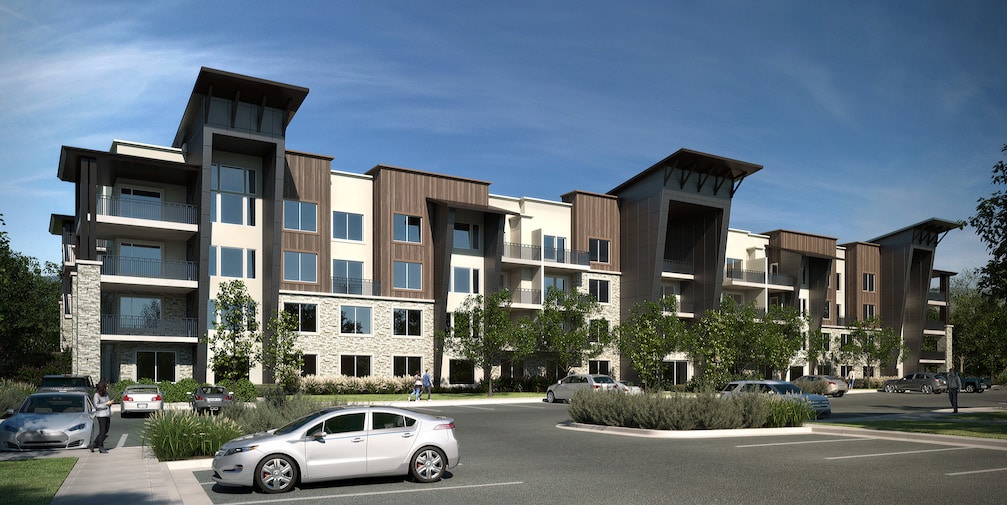We’ve heard many times how the grid of the future will be decentralized, and based on solutions like rooftop solar and batteries to replace large coal, oil and nuclear-powered power plants. But now, this is actually happening.
Yesterday, along with developer Wasatch Group, German battery integrator sonnen introduced its biggest project along these lines to date at the Soleil Lofts in Herriman, Utah, half an hour from Salt Lake City. The new project will feature rooftop solar and 600 of sonnen’s ecoLinx batteries, totaling 5.2 MW / 12.6 megawatt-hours (MWh) of energy storage.
This will be sonnen’s fourth major sonnenCommunity to date in the United States, and a return to the Mountain West where the company announced its first U.S. sonnenCommunity in Jasper, Arizona.
Like the projects in Arizona and Marengo, Illinois, these will be high-end developments, with the Soleil site’s splash page emphasizing luxury; one must scroll down to get to energy efficiency and solar. It also features two pools, spas, a sculpted waterfall, a dog park and of course, 15-foot ceilings.

However, like the sonnenCommunity in Cortez, Florida, the Soleil Lofts will be rental units. The monthly rent was not revealed either on the Soleil Lofts website or in a sonnen press release; however these sorts of developments, built in collaboration with specialized homebuilders, have in most cases been well above the market average.
sonnen in the past has emphasized the need for affordability; however like Tesla’s electric vehicles it may be that the practical path is to first serve the luxury market until enough scale can be achieved to operate in the mass-market.
Working with the utility
But more than the wood-grained floors or the dog park what is important is that the 22-building development and its batteries operate in relationship to the power grid. Under a special contract with the company that owns the development, utility Rocky Mountain Power will operate the batteries, providing management of peak energy and demand response but also allowing tenants to use the batteries to provide back-up power when the grid is down.
This sort of model of utility operation while allowing residents to use the batteries in the event of grid outages is not new; utility Green Mountain Power has been doing this for years through a program with Tesla.
What is different about the Soleil Homes and the other sonnenCommunities is that this is being done at entire developments, essentially creating microgrids that provide services to the larger power grid, including demand response, meaning that this development can be supplying power instead of consuming it at times of peak demand.
Like other sonnenCommunities, there is also an emphasis on efficiency; in the case of Soleil Lofts are not only an estimated 50% more efficient than the average homes but are also 100% electric, with no gas heating or cooking. The solar arrays on the roofs of the buildings are expected to supply the community with 75% of its power.
Moving behind the meter
sonnen’s first sonnenCommunity was announced more than two years ago, and in that time other companies are making progress using behind-the-meter resources as grid assets. Notably both Sunrun and SunPower have won contracts to supply capacity to New England’s grid operator using distributed rooftop solar and batteries, and in California these sorts of clean energy portfolios are replacing retiring fossil fuel-fired plants.
As such, this idea is scaling, both through the distributed assets spread across larger geographic areas and, as in the case of sonnen, development by development.
This content is protected by copyright and may not be reused. If you want to cooperate with us and would like to reuse some of our content, please contact: editors@pv-magazine.com.









By submitting this form you agree to pv magazine using your data for the purposes of publishing your comment.
Your personal data will only be disclosed or otherwise transmitted to third parties for the purposes of spam filtering or if this is necessary for technical maintenance of the website. Any other transfer to third parties will not take place unless this is justified on the basis of applicable data protection regulations or if pv magazine is legally obliged to do so.
You may revoke this consent at any time with effect for the future, in which case your personal data will be deleted immediately. Otherwise, your data will be deleted if pv magazine has processed your request or the purpose of data storage is fulfilled.
Further information on data privacy can be found in our Data Protection Policy.